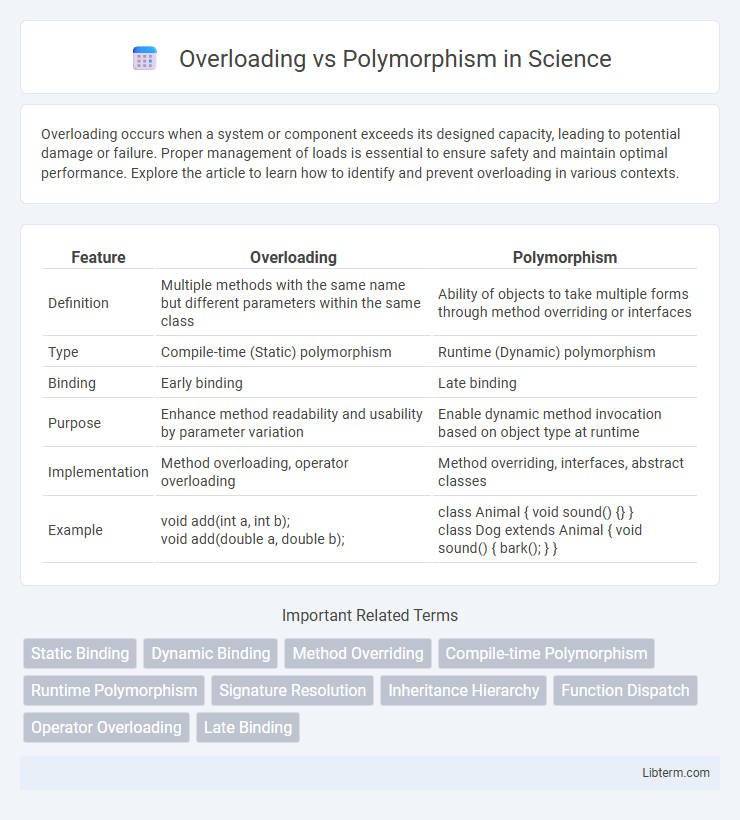Overloading occurs when a system or component exceeds its designed capacity, leading to potential damage or failure. Proper management of loads is essential to ensure safety and maintain optimal performance. Explore the article to learn how to identify and prevent overloading in various contexts.
Table of Comparison
| Feature | Overloading | Polymorphism |
|---|---|---|
| Definition | Multiple methods with the same name but different parameters within the same class | Ability of objects to take multiple forms through method overriding or interfaces |
| Type | Compile-time (Static) polymorphism | Runtime (Dynamic) polymorphism |
| Binding | Early binding | Late binding |
| Purpose | Enhance method readability and usability by parameter variation | Enable dynamic method invocation based on object type at runtime |
| Implementation | Method overloading, operator overloading | Method overriding, interfaces, abstract classes |
| Example |
void add(int a, int b); void add(double a, double b); |
class Animal { void sound() {} } class Dog extends Animal { void sound() { bark(); } } |
Introduction to Overloading and Polymorphism
Overloading allows multiple methods in the same class to share the same name but differ in parameter type or number, enhancing code readability and flexibility. Polymorphism enables objects of different classes to be treated as instances of a common superclass, allowing dynamic method binding and implementation of interface methods. Both concepts are fundamental in object-oriented programming for creating scalable and maintainable software.
Defining Overloading
Overloading refers to the ability of a programming language to define multiple functions or methods with the same name but different parameter lists, enabling compile-time polymorphism. This technique allows for improved code readability and flexibility by handling different data types or numbers of arguments within a single interface. In object-oriented programming, method overloading is essential for creating versatile classes that perform similar operations with varying inputs.
Exploring Polymorphism
Polymorphism in object-oriented programming allows objects of different classes to be treated as instances of the same class through a common interface, enabling dynamic method binding at runtime. This capability enhances code flexibility and scalability by allowing methods to be overridden in derived classes, providing specific implementations while maintaining a unified interface. Exploring polymorphism involves understanding method overriding, dynamic dispatch, and the role of polymorphic behavior in design patterns such as strategy and template method.
Key Differences between Overloading and Polymorphism
Overloading involves defining multiple methods with the same name but different parameter lists within the same class, enabling compile-time (static) polymorphism. Polymorphism, particularly runtime polymorphism, allows objects to be treated as instances of their parent class while invoking overridden methods that execute subclass-specific behavior. Key differences include that overloading is resolved at compile-time through method signature matching, whereas polymorphism is resolved at runtime through dynamic method dispatch.
Types of Overloading
Overloading in programming primarily includes function overloading, operator overloading, and constructor overloading, enabling multiple methods or constructors with the same name but different parameters to coexist. Function overloading allows different functions to perform similar tasks with varying input types or counts, while operator overloading customizes the behavior of operators for user-defined types. Constructor overloading provides multiple ways to initialize objects, enhancing flexibility and readability in object-oriented design.
Types of Polymorphism
Overloading refers to the ability to define multiple methods with the same name but different parameters within the same class, enabling compile-time polymorphism. Polymorphism types include compile-time polymorphism, achieved through method overloading and operator overloading, and runtime polymorphism, realized via method overriding and dynamic method dispatch. Runtime polymorphism leverages inheritance and interfaces to allow objects to be treated as instances of their parent class while invoking the appropriate overridden methods at runtime.
Code Examples: Overloading in Practice
Overloading in practice involves defining multiple methods with the same name but different parameter lists within a class, enabling compile-time polymorphism. For example, a method `add(int a, int b)` can coexist with `add(double a, double b, double c)` to handle various data types and parameter counts. This method signature differentiation allows the compiler to determine the correct method to invoke based on the arguments passed.
Code Examples: Polymorphism in Practice
Polymorphism enables objects of different classes to be treated through a common interface, allowing methods to be overridden to perform class-specific behavior, as demonstrated in code where a base class method is redefined in derived classes. Overloading, by contrast, involves defining multiple methods with the same name but different parameter lists within the same class, facilitating compile-time method selection based on argument types. In practice, polymorphism is illustrated by invoking a method on a parent class reference that dynamically calls the overridden method of a subclass instance, as seen in languages like Java and C++ with virtual functions or interfaces.
Practical Applications in Software Development
Method overloading enhances software development by allowing multiple functions with the same name but different parameters, improving code readability and maintainability in APIs and libraries. Polymorphism supports dynamic method binding, enabling objects to be treated as instances of their parent class, which is essential for designing flexible and extensible systems like GUI frameworks and design patterns such as Strategy or State. Practical applications of these concepts streamline code reuse, reduce errors, and facilitate the implementation of scalable and modular software architectures.
Choosing the Right Approach: Best Practices
Choosing the right approach between overloading and polymorphism depends on specific use cases and design goals; overloading is best for compile-time method differentiation based on parameter lists, while polymorphism excels in runtime behavior modification through inheritance and interfaces. Use overloading to simplify code readability when methods perform similar tasks with different inputs, and favor polymorphism for scalable, maintainable systems that require dynamic behavior changes. Adhering to best practices involves assessing performance impacts, enhancing code flexibility, and maintaining clear separation of concerns in object-oriented design.
Overloading Infographic

 libterm.com
libterm.com